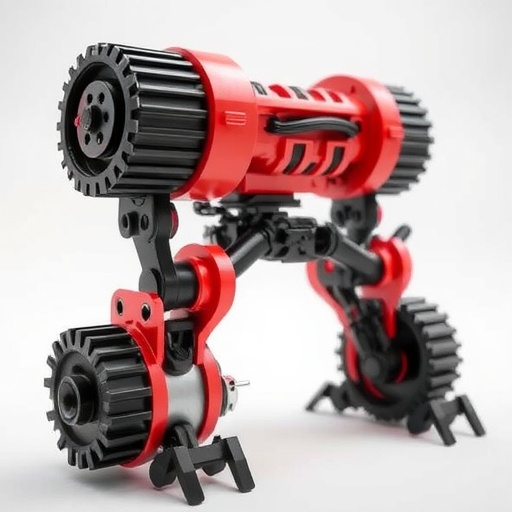In a groundbreaking advance poised to revolutionize surgical procedures and robotic safety systems, researchers have unveiled a novel mechanism centered on slipknots that precisely calibrate mechanical force transmission. This innovation harnesses the seemingly simple yet remarkably sophisticated physics of slipknots to develop “sliputures”—surgical sutures integrated with mechanical force gauges capable of real-time force modulation without electronic inputs. Crafted through a rigorously standardized fabrication process involving 3D-printed guiding boards, these slipknots are formed with exact forces, ensuring reproducibility critical for clinical and robotic applications.
The meticulous process employs a Zwick/Roell Z010 testing machine that tensions the slipknot to a preset force, simulating the precise conditions necessary for reliable function. High-speed camera technology capturing up to 11,000 frames per second illuminates the dynamic evolution of the slipknot’s configuration upon force release, offering insight into the intricate mechanical behavior that underpins their stable yet responsive nature. Complemented by high-resolution micro-CT scans with sub-micrometer voxel precision, the internal 3D structure of slipknots at various states is reconstructed, revealing how tension affects their geometry and interactions at microscopic scales.
Finite element method (FEM) simulations based on elastoplastic material models faithfully replicate slipknot deformation under tying, tightening, and opening sequences. Through this computational approach, incorporating realistic friction coefficients and material hardening behavior, researchers visualize tension distribution and contact mechanics, confirming the slipknot’s ability to sustain and control loads precisely. Such detailed modeling informs the design parameters necessary to tailor slipknots for specific force thresholds, integral for their function as mechanical fuses in surgical and robotic contexts.
Experimental testing demonstrates remarkable consistency across hundreds of samples, where variables such as the number of knot loops, string diameter, and preset tying force modulate the peak opening force of the slipknot with predictable precision. Furthermore, friction assessments under dry, moist, and lubricated conditions, using relevant biological fluids analogous to surgical environments, authenticate the slipknot’s reliability and robustness. This comprehensive characterization affirms sliputures as viable force-measuring devices capable of maintaining function in diverse physiological environments.
To bridge laboratory innovation with surgical practicality, researchers developed wearable and bimanual real-time dynamometers that monitor the knot-tying forces exerted by surgeons, differentiating between skill levels and bolstering the precision of mechanical transmission through slipknot-embedded sutures. Clinical testing involving both novice and veteran surgeons reveals the potential of sliputures to standardize knot force application, enhancing safety, and reducing undue tissue stress. These findings foreshadow a paradigm shift in surgical training and practice, where force feedback is intrinsically encoded within the suture construct.
The mechanical validation extends into silicone practice models that simulate human tissue, employing pressure-sensitive films to quantify incision pressures exerted by slipknot-enabled standing and continuous sutures. Comparative analyses highlight the slipknot’s proficiency in distributing force evenly and minimizing tissue ischemia—a fundamental goal in surgical wound healing and patient recovery. The translational impact is further demonstrated through in vivo rodent and porcine models. Here, sliputures afford controlled force release during colonic injury repairs, significantly mitigating anastomotic leakage, adhesion formation, and vascular compromise when juxtaposed to conventional suturing methods.
Recognizing the importance of automation in scaling medical innovations, the research team engineered an automated production system capable of manufacturing sliputures with tailored mechanical properties at high throughput. This system incorporates precision wire feeding, force feedback control, and autonomous wrapping, delivering consistent quality essential for widespread clinical deployment. Integration with cutting-edge robotic systems, including the da Vinci Xi surgical platform augmented by a vision-based slipknot detection algorithm, enables real-time monitoring that halts robotic movement upon slipknot activation, enhancing procedural safety during minimally invasive surgery.
The versatility of the slipknot mechanism transcends medicine. By embedding the slipknot within the tendon-driven transmission of a custom-built robotic arm, the researchers demonstrate a purely mechanical safety fuse that interrupts force transmission upon overload, protecting both human operators and robotic components. This innovation eliminates the need for auxiliary sensors or electronics, streamlining integration into existing robotic architectures and advancing safe human–robot interaction paradigms crucial for collaborative automation and industry 5.0 ecosystems.
On a molecular scale, coarse-grained molecular dynamics simulations elucidate the behavior of slipknot-like knots in DNA strands, indicating potential applications in nanotechnology and biophysics, where controlled mechanical responses at nanoscale precision are desired. This confluence of macroscopic engineering, surgical innovation, and molecular modeling epitomizes a multidisciplinary approach driving forward the frontiers of biomedical and robotic technology.
Statistical rigor underpins the reported results, ensuring technical excellence and reproducibility. Multiple testing modalities, with well-defined sample sizes and rigorous controls, validate the mechanical consistency, clinical feasibility, and biological compatibility of slipknot-based systems. Animal studies conducted under stringent ethical oversight further reinforce the biological safety and translational potential of this approach. The open-source release of engineering code and datasets promotes transparency and accelerates adoption and further innovation across medical and robotic communities.
Collectively, this research heralds a transformational leap in the interface between mechanical engineering and clinical practice. Slipknot-gauged mechanical transmission offers a minimalist, elegant solution for precise force control— a critical parameter historically challenging to quantify and regulate during surgical interventions and robotic interactions. By intertwining classical knot mechanics with contemporary fabrication, sensing, and control technologies, the study opens pathways toward safer surgeries, smarter robotics, and innovative biomimetic devices poised to impact diverse scientific domains.
Subject of Research: Development of slipknot-gauged mechanical force transmission systems for surgical and robotic applications.
Article Title: Slipknot-gauged mechanical transmission and robotic operation.
Article References:
Xue, Y., Cao, J., Feng, T. et al. Slipknot-gauged mechanical transmission and robotic operation. Nature 647, 889–896 (2025). https://doi.org/10.1038/s41586-025-09673-w
Image Credits: AI Generated
DOI: 27 November 2025
Tags: 3D-printed guiding boardsadvanced surgical procedures with slipknot innovationselastoplastic material modelingfinite element method simulationshigh-speed camera technology in roboticsmechanical behavior of slipknot configurationsreal-time force modulationrobotic applications of slipknot technologyrobotics safety systemsslipknot geometry and tensionslipknot mechanical transmissionsurgical sutures with force gauges




